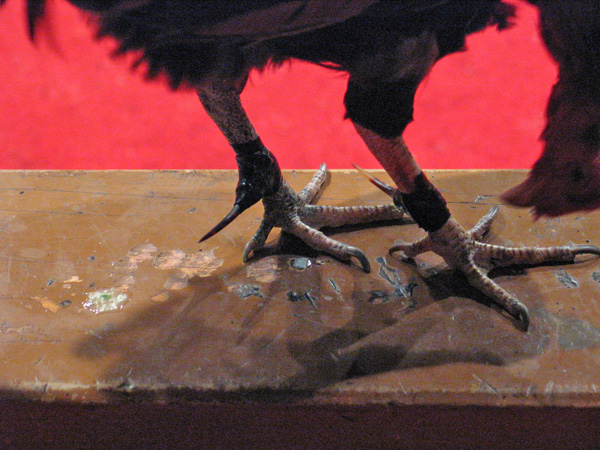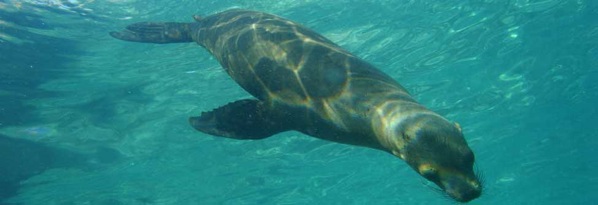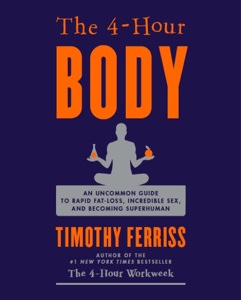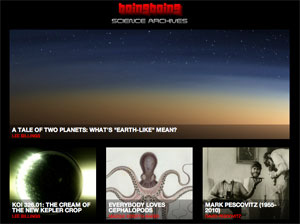The Latest from Boing Boing |  |
- Alpha: science fiction writing workshop for teens in Pittsburgh
- High-ranking Scientologist's defection, in detail
- Alan Moore loves libraries
- Brr.
- Cockfighting rooster kills California man
- Gelaskins: scratch protection for just about anything
- Verizon iPhone has redesigned vibrator
- Apple Wireless Keyboard
- San Francisco Bay Area: Run for the Seals, Saturday
- Holding your breath like David Blaine (and Tim Ferriss!)
- Video: Davis 3 Wheeler car (1948)
- In which I am a sucker for fancy versions of bad food
- The science of free diving
- Michel Gagné's "Insanely Twisted Shadow Planet" game trailer
- Easy CC Attribution with Open Attribute
- Photos of industrial landscapes
- Search Engine explains the Streisand Effect
- Minecraft Creeper onesie
- Butter as murder weapon
- Army ants will not eat you
- Man busted after calling 911 to ask about growing pot
- Valentine's Day cards + science = awesome
- Boing Boing nominated for science Bloggie
- Exploring Kepler's library
- Wheelchair for the developing world: cheap, rugged and easy to maintain
- HOWTO get the cheapest plane ticket
| Alpha: science fiction writing workshop for teens in Pittsburgh Posted: 08 Feb 2011 04:11 AM PST Alpha is a science fiction/fantasy/horror writing workshop for young people aged 14-19, held at University of Pittsburgh's Greensburg Campus from July 13-22 (it leads up to the annual Pittsburgh science fiction convention, Confluence, which runs July 22-24). This year's instructors include Tamora Pierce, David Levine and Ellen Kushner (I've taught a workshop with Ellen before and she's fab, as, I'm sure, are David and Tamora). Tuition is $995, and the application deadline is March 1. The Alpha SF/F/H Workshop for Young Writers (via Whatever) |
| High-ranking Scientologist's defection, in detail Posted: 08 Feb 2011 03:58 AM PST A long (frankly, overlong) piece in the New Yorker by Lawrence Wright gives the backstory of celebrated writer/director Paul Haggis's defection from the Church of Scientology. Haggis had been a high profile member, defender and fundraiser for the Church for most of his life, but a series of disenchanting events -- the Church's support for the California gay-marriage ban, public lies about the practice of ordering members to sever ties with family, revelations about child labor abuses on the maritime Sea Org -- caused Haggis to publicly split with the Church. I've casually followed scandals regarding the C of S for decades, mostly out of curiousity about the "free personality tests" I'd see as a kid, and later, because of high-profile anti-anonymity/dirty tricks involving the Internet, starting with the outing of the users of the anon.penet.fi remailer. There wasn't an enormous amount of new material in here, though Wright does a good job of spinning out Haggis's remarkable life in Scientology and in the entertainment industry, and, towards the end, some damning material about physical abuse and financial malfeasance from the Church's highest leaders. I have three or four friends who are second-generation Scientologists, including one guy who met his wife in the Sea Org and is particularly devout. I've always found it hard to reconcile their otherwise-reasonable outlooks with some of the more immediately falsifiable claims made by the Church (for example, the claim that electric charges leave the body when bad memories are recalled, and that enough of this will eventually uncover memories from past lives). This stuff isn't potentially allegorical or a story out of the distant galactic past -- rather, it's an article of faith pertaining to a regular, public ritual that makes scientific claims that are just plain wrong, like, Bill O'Reilly, Mars-doesn't-have-moons wrong. Wright's article illuminates the mindset you have to get into to believe this and still participate in rational discussion on other matters, and this is where the piece shines brightest. But if the 26,000-word piece drags a bit (and it does), it also provides a vivid look at the way the Church rose to power and the remarkable clash between the Church's culture of secrecy and the Internet's capacity to blow open the doors. The Apostate (Thanks, Jack, via Submitterator!) (Image: SCIENTOLOGY Neon Sign, a Creative Commons Attribution (2.0) image from mylifeafterdeath's photostream)
|
| Posted: 07 Feb 2011 11:15 PM PST Alan Moore, one of the high priests of happy mutants, gives a ringing endorsement to the public library system in this brief clip from last Saturday "Save our Libraries" international event. Moore spoke at the St. James Library in Northhampton. Save our Libraries: Alan Moore (Thanks, MindySan33, via Submitterator!)
|
| Posted: 07 Feb 2011 10:03 PM PST It looks as if this guy filmed this whole crazy clip himself with no one else around. (via The Awesomer) |
| Cockfighting rooster kills California man Posted: 07 Feb 2011 10:31 PM PST  We've seen matadors get their comeuppance before, but here's another entry in Boing Boing's ongoing series of animal karma: during the commotion at a police raid of a cockfight, one of the roosters decked out with razor-sharp blades cut a guy so badly he died. The headlines write themselves, so please add yours in the comments. Also, cocks. We've seen matadors get their comeuppance before, but here's another entry in Boing Boing's ongoing series of animal karma: during the commotion at a police raid of a cockfight, one of the roosters decked out with razor-sharp blades cut a guy so badly he died. The headlines write themselves, so please add yours in the comments. Also, cocks. Tulare County man dies after being cut by knife attached to cockfighting rooster's leg (Tulare Advance Register) Image: Cockfighting spurs via Wikimedia Commons |
| Gelaskins: scratch protection for just about anything Posted: 07 Feb 2011 04:03 PM PST  Gelaskins sent over one of its new laptop skins. Peel 'n' stick covers cut from sheets of 3M Controltac, it goes on easily—not so sticky that it's hard to reposition or push out air bubbles, but sticky enough not to peel when you rub your thumb against the edge. Gelaskins sent over one of its new laptop skins. Peel 'n' stick covers cut from sheets of 3M Controltac, it goes on easily—not so sticky that it's hard to reposition or push out air bubbles, but sticky enough not to peel when you rub your thumb against the edge. Print quality is excellent, though the glossy surface reveals the underlying material's gridded texture. It's apparently the same stuff that corporate car fleet decals are made from. And while some cuts come with sheets for both sides (such as the Kindle skin), the laptop ones are one-sided. The 11" MacBook Air, for example, has no vents or licensing info underneath and could have done with a "side B" skin so that the whole laptop is protected. That said, this is a relatively inexpensive way to make your computer gear safe from basic scratches and scuffs without adding weight or size: hard to go wrong, given that you can upload your own designs.
|
| Verizon iPhone has redesigned vibrator Posted: 07 Feb 2011 02:30 PM PST  Verizon's iPhone might look little different to the old model on the outside, but the guts share little in common. iFixit's ripped one up and reports significant differences beyond what's necessary to switch GSM and CDMA radios. Verizon's iPhone might look little different to the old model on the outside, but the guts share little in common. iFixit's ripped one up and reports significant differences beyond what's necessary to switch GSM and CDMA radios. The location and design of the RF components--EMI (electromagnetic interference) shields, connector locations, even board layout--is changed. They redesigned the vibrator--a seemingly minor item, but it takes up a large amount of space inside the phone. My tester said that the "Verizon vibration was quieter, a little softer to feel, and made a better sound on the table." (No, I'm not making a 'That's what she said' joke.)The real news is that the chipset also supports both GSM and CDMA, suggesting "universal" models may be forthcoming. Verizon iPhone Teardown [iFixit] |
| Posted: 07 Feb 2011 01:31 PM PST  Apple's newest iteration of their wireless keyboard is one of the best pieces of design to have ever come out of Cupertino. For the past year this slim aluminum-milled chiclet-styled keyboard commands a central position on my desk (unlike, that is, any Apple mouse). It is simply one of those products that is so well made that if they end production I might have to buy several replacements. The minimalist design has been boiled down to the essence of a functioning keyboard. It lacks a numeric keypad (a feature that can only be found on Apple's wired keyboard but that I have no need for anyway). It has none of the unnecessary battery draining features found on other third party wireless keyboards and features only one LED (for caps lock). This means that the keyboard can run for several months on two rechargeable AA batteries (I have charged it twice in 12 months) without ever having to turn it off. The pint-sized (12.8" x 7.3" x 1.4") 11.5 ounce keyboard is dwarfed by other monster desktop keyboards but holds its own and has the added benefit of being small enough to slip into a laptop bag for on-the-go use alongside any Bluetooth-enabled device. Apple's newest iteration of their wireless keyboard is one of the best pieces of design to have ever come out of Cupertino. For the past year this slim aluminum-milled chiclet-styled keyboard commands a central position on my desk (unlike, that is, any Apple mouse). It is simply one of those products that is so well made that if they end production I might have to buy several replacements. The minimalist design has been boiled down to the essence of a functioning keyboard. It lacks a numeric keypad (a feature that can only be found on Apple's wired keyboard but that I have no need for anyway). It has none of the unnecessary battery draining features found on other third party wireless keyboards and features only one LED (for caps lock). This means that the keyboard can run for several months on two rechargeable AA batteries (I have charged it twice in 12 months) without ever having to turn it off. The pint-sized (12.8" x 7.3" x 1.4") 11.5 ounce keyboard is dwarfed by other monster desktop keyboards but holds its own and has the added benefit of being small enough to slip into a laptop bag for on-the-go use alongside any Bluetooth-enabled device.  Outside of aesthetics, the keyboard provides one of the most pleasant tactile writing experiences. The angle of the keyboard's surface (formed by the battery compartment) is perfect for extended periods of writing. The thin aluminum edge at the front keeps the keyboard close to the desk allowing my wrist to rest directly on the table unlike other raised keyboards and doesn't dig into my skin or limit circulation. In addition, after a year of hard use (I am tough on my keyboards) it looks brand new with no wear showing on the keys. And because it doesn't have the deep crevices between keys there is little room for cruff to get caught, and a simple spray with compressed air eliminates any residue. Typing is fluid and easy and I believe Apple has perfected the amount of pressure required to push the keys down. The sound of typing is minimal and not distracting like some of the other hammer keys out there. Simply put, it is one of those products that disappears when in use, allowing you to do what you need to do efficiently.
As far as its wireless capabilities, the range of the Bluetooth wireless signal is impressive. I have managed to use it to pause music playing from two stories up (around 30 ft away). I was wary of using Bluetooth because in the past I have found it to be finicky, but in a year of use I haven't had a single connection problem. While many may groan at the sight of an expensive Apple product, I believe this keyboard is a peacemaker. It isn't proprietary (for those on PCs, the Apple-centric function keys simply revert to traditional F1-F12), it won't require you to relearn how to use a computer, and it doesn't even have a visible Apple logo (for all the haters out there). But above all else it is the best keyboard I have ever had the pleasure of using. [Note: There is a great thread over at Cool Tools covering the benefits of some of the older clickier IBM Model M keyboards and where to buy new copies of them today. -- OH] --Oliver Hulland Comment on this at Cool Tools. Or, submit a tool! |
| San Francisco Bay Area: Run for the Seals, Saturday Posted: 07 Feb 2011 12:11 PM PST   Every year since my wife and I have moved to Marin, CA we've participated in the "Run for the Seals' ." Like a starry-eyed fanboy I've relayed to you word of the good these guys are busy delivering on for our sea-faring mammalian colleagues -- now you've got the opportunity to go participate in a fairly intimate, well organized and oft educational festival in the Marin Headlands this Saturday, March 12. While the focus is on a brief 4mi (or 2 for even less competitive) run/walk, TMMC always has a fair number of local organizations sharing info on everything from the Humane Society, not polluting our oceans with potentially whale damaging sound, sustainable living and SF Giants Baseball (my dog seems to like Lou Seal.) Every year since my wife and I have moved to Marin, CA we've participated in the "Run for the Seals' ." Like a starry-eyed fanboy I've relayed to you word of the good these guys are busy delivering on for our sea-faring mammalian colleagues -- now you've got the opportunity to go participate in a fairly intimate, well organized and oft educational festival in the Marin Headlands this Saturday, March 12. While the focus is on a brief 4mi (or 2 for even less competitive) run/walk, TMMC always has a fair number of local organizations sharing info on everything from the Humane Society, not polluting our oceans with potentially whale damaging sound, sustainable living and SF Giants Baseball (my dog seems to like Lou Seal.) I'm running and while you don't have to -- its a lot of fun. You can also walk your kid, your dog or push your kid or dog in a stroller. I've seen it all. If you want to run, here are the details. If you want to sponsor my running, I'd appreciate that too. Details here.I am slow and promise nothing beyond finishing. On a sadder note, as we shared a few weeks back, some jerk shot a seal in the face. TMMC has been dutifully caring for the seal, named Silent Knight, and he's improving. Latest updates revolve around his learning new ways to eat before they move him to a new and permanent facility; blinded -- he will never be able to care for himself in the wild again. However he appears to be doing well and is gaining weight at a steady clip. "In fact, Silent Knight is eating so well that his feed has been reduced to 2.75 kilograms (6.05 lb) three times daily as he has now reached an appropriate weight for his size. His new weight is now 157 kilograms (345.4 lb), up from a prior weight of 142.5 kilograms (313.5 lb) on 1/11/11." You can follow his progress here. |
| Holding your breath like David Blaine (and Tim Ferriss!) Posted: 07 Feb 2011 12:56 PM PST Reading Maggie's fascinating post today about the "science of free diving," I was reminded of a section I just read in Tim Ferriss's book "The 4-Hour Body: An Uncommon Guide to Rapid Fat-Loss, Incredible Sex, and Becoming Superhuman," which I'm thoroughly enjoying. Tim talks about meeting David Blaine at a TEDMED conference (video above) where he asked him how he was able to hold his breath for 17 minutes and 4.4 seconds, a world record at the time. Blaine kindly taught Tim and a dozen others his method. From Tim's blog: Don't try this at home, but here's Tim Ferriss on "How to Hold Your Breath Like David Blaine, World Record Holder (and Now, Me)" |
| Video: Davis 3 Wheeler car (1948) Posted: 07 Feb 2011 11:19 AM PST "This little chariot can really run you around in circles." I'd certainly like a Davis 3-Wheeler. And a 1950s voice like the narrator too. (Thanks, Jeff Cross!) |
| In which I am a sucker for fancy versions of bad food Posted: 07 Feb 2011 10:20 AM PST From Saveur, the fine folks who brought you the fancy, slow-food McRib, comes a recipe for a home-made, chicken Cordon Bleu-inspired version of the KFC Double Down. |
| Posted: 07 Feb 2011 10:12 AM PST This video is the sort of thing that makes proponents of the (most likely incorrect) aquatic ape theory giddy. But what you see when you watch a man dive for more than two minutes on a single breath isn't so much a sign of previous primate life in the water, but rather an example of a far better evolutionary skill—a human being's ability to self-adapt. In a long, thorough, and fascinating post at the Neuroanthropology blog, Greg Downey explains how innate biology, specific cultural behaviors, and lifelong training combine to make a feat like prolonged free diving possible—and what negative trade-offs the free divers accept in return for their adaptive skill.
Neuroanthropology: Human (amphibious model): living in and on the water |
| Michel Gagné's "Insanely Twisted Shadow Planet" game trailer Posted: 07 Feb 2011 09:54 AM PST "Insanely Twisted Shadow Planet" is a forthcoming indie game developed by shadow puppet artist/painter Michel Gagné, produced by Fuelcell Games. Andrew Scott, whose amazing bug sculptures I've featured before, is doing the sound design. Interestingly, the game was inspired by a series of Halloween interstitials that Gagné created for Nickelodeon in 2005. I'm sure the videogame will be terrific, but I think Nickelodeon should commission Gagné to do a regular cartoon series! You can see more about the game at the "Insanely Twisted Shadow Planet" site and watch the 2005 interstitials after the jump. (Thanks, Stacey Ransom!) |
| Easy CC Attribution with Open Attribute Posted: 07 Feb 2011 09:46 AM PST Mollyak sez, "Open Attribute is a suite of tools that make it simple to copy and paste the correct attribution for any Creative Commons licensed work on the web. Today we released add-ons for Firefox and Chrome that query the metadata around a CC-licensed object and produce a properly formatted attribution that users can copy and paste wherever they need to, in both plain text and RDF." |
| Photos of industrial landscapes Posted: 07 Feb 2011 09:44 AM PST  David Biello has a thought-provoking slideshow up on Scientific American today. It features eerily beautiful snapshots of industrial processes and fossil fuel development that are, simultaneously, necessary to our current way of life, and kind of horrible to look at. This picture, for instance, is of a mountaintop-removal site, where layers of trees and earth are scraped away—and backfilled into valleys nearby—in order to reach coal deposits.
|
| Search Engine explains the Streisand Effect Posted: 07 Feb 2011 09:35 AM PST Jesse Brown's latest video Search Engine podcast is a fine and funny explanation of the Streisand Effect, with examples from around the world. What is 'The Streisand Effect'? (Thanks, Jesse!)
|
| Posted: 07 Feb 2011 09:32 AM PST  ThinkGeek's "Minecraft Creeper Creeper" is a onesie for the parent who wants his kid to look like a pixelated, somewhat abstract monster from the cult-sensation game Minecraft.
|
| Posted: 07 Feb 2011 09:10 AM PST A man and his girlfriend murdered the woman's ex-husband with a slab of butter in southern Sicily, according to the Corriere della Sera. They suffocated him with the butter, expecting the murder weapon to have melted by the time police arrived. From AFP: But a post-mortem found remains of the butter in the airways of Calogero Lo Cocco and the pair were unmasked, the paper said..."Sicily couple murdered man with butter" |
| Posted: 07 Feb 2011 09:21 AM PST Alex Wild, biologist and photographer, recently made this short video of army ants marching through the wilds of Ecuador. These creatures travel in packs—hundreds of thousands of ants strong—and they are not vegetarians. That said, they're also not out there, stripping cows to bone in 20 seconds flat. Tales of South American army ants devouring large vertebrates are myths. Instead, they eat insects, worms, arthropods and eggs. They do kill small vertebrates—think, toads—that get in their way. But they lack the right sort of jaws to actually eat those animals. At least, that's true for the New World version of the army ant. Same can't be said about its African cousins. Of course, just because something can't kill and eat you doesn't mean it's entirely benign, as Alex Wild well knows:
(Via Kate Clancy) |
| Man busted after calling 911 to ask about growing pot Posted: 07 Feb 2011 08:46 AM PST Robert Michelson, 21, of Farmington, Connecticut, called 911 to inquire about the possible legal consequences of growing a marijuana plant. He's now been charged with marijuana possession and "other crimes," according to the AP: Farmington police say a dispatcher told... Michelson on Thursday night that he could get arrested for growing pot, and Michelson said thank you and hung up."Conn. Man Asks Cops About Growing Pot, Is Arrested" |
| Valentine's Day cards + science = awesome Posted: 07 Feb 2011 08:36 AM PST  Although they lack the often-creepy Dadaism of 1980s Super Friends valentines, these science-themed Valentine's Day cards—made by stephoodle on Etsy—are utterly charming. My only complaint: I wish there were more female scientists in the mix. (Insert your own Jane Goodall Valentine's Day card joke here.) Submitterated by Scixual |
| Boing Boing nominated for science Bloggie Posted: 07 Feb 2011 08:58 AM PST
Recent features we've posted there include Everybody loves cephalopods and Gliese 581g: Coolness in context by Maggie; Death in Space, by Mary Roach; some awesome space colonies, and A tale of two planets from Billings; and Dr. Dawkins' discussion of the relevance of private belief in science employment. Many thanks to those who nominated us! Visit our BB science archive and be sure to check our the other nominees, David Robertson, Wired Science, Watts Up With That?, and Women in Planetary Science. To cast your votes, click the little gray circles at the Bloggi.es homepage, then scroll to the bottom and fill out the captcha. |
| Posted: 07 Feb 2011 07:04 AM PST Last week's data release from Kepler appears to have temporarily overwhelmed both professional and amateur exoplanet enthusiasts. After the initial flurry of basic overview posts on the Kepler data, I noticed a conspicuous hush fall over many of my favorite astronomy blogs, presumably caused by their authors turning en masse to parse the new treasure trove. The list of more than 1200 candidate planets will likely yield more than a thousand actual confirmed worlds once culled of false positives. One system, Kepler-11, contains six confirmed transiting planets, and another system, KOI 157, has five candidates. Eight systems have been found with four candidate planets, along with 45 triple-planet and 115 double-planet systems. It's a lot to digest, and only represents the first four months of data from a 3.5-year mission. Fortunately, the incapacitating shock of the breadth and depth of the new dataset seems to be wearing off, and researchers are beginning to reveal some of their initial explorations. In particular, Daniel Fabrycky, a University of California-Santa Cruz astronomy post-doc and member of the Kepler team, has created an impressive visualization of projected orbital motions for all the multi-planet systems Kepler has discovered to date. Within each system, planets are color-coded according to size, with the redder planets being larger and bluer planets being smaller. It's hard to overstate the magnitude of the insights that can potentially be extracted from novel presentations of Kepler's raw data and its present and future planetary ensemble. Though each planetary system constitutes an essentially static snapshot of only one outcome from eons-long stochastic processes, lurking in the aggregate are lessons about how exactly planets form, how orbital configurations change over time, the relative distributions of planetary size, and frequency and how a star's age, size, and mass determine the sorts of planets it produces. Sometimes these rules and the relationships between them may clearly manifest through a simple chart or graph of two key variables, but in other cases they may only reveal themselves through more dynamic presentations and multivariate analyses that better leverage the pattern-recognition capabilities of people. In this way, Kepler's large, diverse data sets may stimulate not only a more robust understanding of stellar and planetary science, but also significant progress in the effective design and usage of scientific data visualization. For example, novel visualizations of stellar light curves from Kepler's first batch of data, released in June 2010, allowed members of the citizen-science project Planethunters.org to preliminarily identify 83 candidate planets that were only confirmed in last week's data release. The same visualizations, which plot dips in the brightness of the more than 150,000 Kepler monitors, also yielded what may prove to be 47 additional candidate planets that slipped through the Kepler team's automated pipeline. Many fainter, subtler signals of smaller planets in habitable orbits around larger stars are certainly present unrecognized in the most recent dataset—borderline events that won't trigger a flag in a software routine but will catch the human eye. More people should be looking—there is a not-insignificant chance that with a bit of luck and careful observation, you could discover a potentially Earth-like world in Kepler's data even before the mission's scientists do.
|
| Wheelchair for the developing world: cheap, rugged and easy to maintain Posted: 06 Feb 2011 10:38 PM PST  Core77's case-study of the MIT Mobility Lab's "Leveraged Freedom Chair" is a fascinating look at the difficulties presented by designing a sustainable wheelchair for use by disabled people in the developing world. The final product can be sold for $100 -- a 90 percent reduction off traditional wheelchairs -- and uses a lever-driven propulsion system that works better over rough terrain. It uses bicycle parts to keep costs down and simplify maintenance. Case Study: Leveraged Freedom Chair, by Amos Winter and Jake Childs
|
| HOWTO get the cheapest plane ticket Posted: 07 Feb 2011 05:37 AM PST Gulliver, the regular travel column in The Economist, has some interesting tips for getting the best airfare: book eight weeks in advance, in the middle of the week. |
| You are subscribed to email updates from Boing Boing To stop receiving these emails, you may unsubscribe now. | Email delivery powered by Google |
| Google Inc., 20 West Kinzie, Chicago IL USA 60610 | |

 Learn about writing and publishing. Meet other teens who share your interest in writing speculative fiction. Talk about short stories, novels, and films. Have your submission story critiqued. Brainstorm new story ideas, write a first draft, receive feedback, and rewrite. Attend readings by the authors. Do a public reading. Learn about submitting for publication, and send off your story at our manuscript mailing party...
Learn about writing and publishing. Meet other teens who share your interest in writing speculative fiction. Talk about short stories, novels, and films. Have your submission story critiqued. Brainstorm new story ideas, write a first draft, receive feedback, and rewrite. Attend readings by the authors. Do a public reading. Learn about submitting for publication, and send off your story at our manuscript mailing party...  At his house, Haggis finished telling his friends what he had learned. He suggested that they should at least examine the evidence. "I directed them to certain Web sites," he said, mentioning Exscientologykids.com, which was created by three young women who grew up in Scientology and subsequently left. Many stories on the site are from men and women who joined the Sea Org before turning eighteen. One of them was Jenna Miscavige Hill, David Miscavige's niece, who joined when she was twelve. For Hill and many others, formal education had stopped when they entered the Sea Org, leaving them especially ill-prepared, they say, for coping with life outside the church.
At his house, Haggis finished telling his friends what he had learned. He suggested that they should at least examine the evidence. "I directed them to certain Web sites," he said, mentioning Exscientologykids.com, which was created by three young women who grew up in Scientology and subsequently left. Many stories on the site are from men and women who joined the Sea Org before turning eighteen. One of them was Jenna Miscavige Hill, David Miscavige's niece, who joined when she was twelve. For Hill and many others, formal education had stopped when they entered the Sea Org, leaving them especially ill-prepared, they say, for coping with life outside the church. 


 What were the results of his training?
What were the results of his training?
Tidak ada komentar:
Posting Komentar